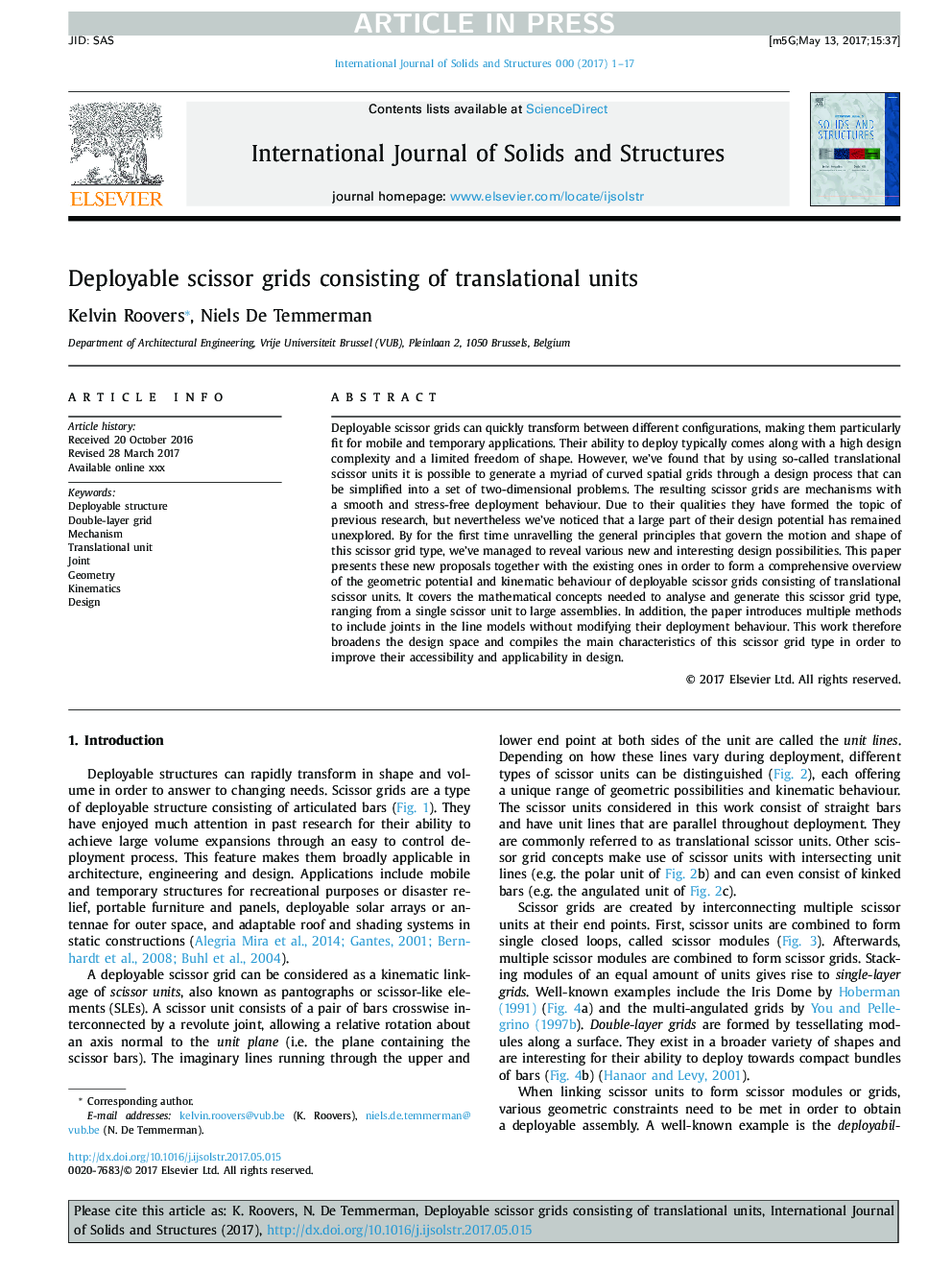| کد مقاله | کد نشریه | سال انتشار | مقاله انگلیسی | نسخه تمام متن |
|---|---|---|---|---|
| 4922306 | 1430182 | 2017 | 17 صفحه PDF | دانلود رایگان |
عنوان انگلیسی مقاله ISI
Deployable scissor grids consisting of translational units
ترجمه فارسی عنوان
شبکه قیچی قابل انعطاف که شامل واحدهای ترجمه است
دانلود مقاله + سفارش ترجمه
دانلود مقاله ISI انگلیسی
رایگان برای ایرانیان
کلمات کلیدی
ترجمه چکیده
شبکه های قیچی قابل انعطاف می توانند به سرعت بین تنظیمات مختلف تبدیل شوند و به ویژه برای برنامه های تلفن همراه و موقت مناسب باشند. توانایی آنها برای استقرار به طور معمول همراه با پیچیدگی طراحی بالا و آزادی محدود شکل است. با این حال، ما متوجه شده ایم که با استفاده از واحدهای قیچی به اصطلاح، می توان از طریق یک فرآیند طراحی یک هزاران شبکه گره های منحنی تولید کرد که می تواند به مجموعه ای از مشکلات دو بعدی ساده شود. شبکه های قیچی حاصل مکانیسم هایی با رفتار استقرار صاف و بدون استرس می باشند. با توجه به ویژگی های آنها، موضوع تحقیق قبلی را شکل داده اند، اما با این وجود ما متوجه شده ایم که بخش بزرگی از پتانسیل طراحی آنها هنوز کشف نشده است. برای اولین بار از اصول کلی که بر حرکت و شکل این نوع شبکه قیچی حکمرانی می کنند، ما توانستیم امکانات مختلف جدید و جالب طراحی کنیم. این مقاله این پیشنهادهای جدید را همراه با آنهایی که در حال حاضر ارائه شده است، به منظور ارائه یک مرور جامع از پتانسیل هندسی و رفتار سینماتیک شبکه های قیچی قابل انعطاف که شامل واحدهای قیچی ترجمه می شود. این مفاهیم ریاضی مورد نیاز برای تجزیه و تحلیل و تولید این نوع شبکه قیچی را شامل می شود که شامل یک واحد قیچی تک به مجموعه های بزرگ می باشد. علاوه بر این، مقاله روش های متعددی را شامل می شود که شامل اتصالات در مدل های خطی بدون اصلاح رفتار استقرار آنها است. این کار به این ترتیب فضای طراحی را گسترش می دهد و ویژگی های اصلی این نوع شبکه قیچی را به منظور بهبود دسترسی و کاربرد آن در طراحی طراحی می کند.
موضوعات مرتبط
مهندسی و علوم پایه
سایر رشته های مهندسی
مهندسی عمران و سازه
چکیده انگلیسی
Deployable scissor grids can quickly transform between different configurations, making them particularly fit for mobile and temporary applications. Their ability to deploy typically comes along with a high design complexity and a limited freedom of shape. However, we've found that by using so-called translational scissor units it is possible to generate a myriad of curved spatial grids through a design process that can be simplified into a set of two-dimensional problems. The resulting scissor grids are mechanisms with a smooth and stress-free deployment behaviour. Due to their qualities they have formed the topic of previous research, but nevertheless we've noticed that a large part of their design potential has remained unexplored. By for the first time unravelling the general principles that govern the motion and shape of this scissor grid type, we've managed to reveal various new and interesting design possibilities. This paper presents these new proposals together with the existing ones in order to form a comprehensive overview of the geometric potential and kinematic behaviour of deployable scissor grids consisting of translational scissor units. It covers the mathematical concepts needed to analyse and generate this scissor grid type, ranging from a single scissor unit to large assemblies. In addition, the paper introduces multiple methods to include joints in the line models without modifying their deployment behaviour. This work therefore broadens the design space and compiles the main characteristics of this scissor grid type in order to improve their accessibility and applicability in design.
ناشر
Database: Elsevier - ScienceDirect (ساینس دایرکت)
Journal: International Journal of Solids and Structures - Volume 121, 15 August 2017, Pages 45-61
Journal: International Journal of Solids and Structures - Volume 121, 15 August 2017, Pages 45-61
نویسندگان
Kelvin Roovers, Niels De Temmerman,
